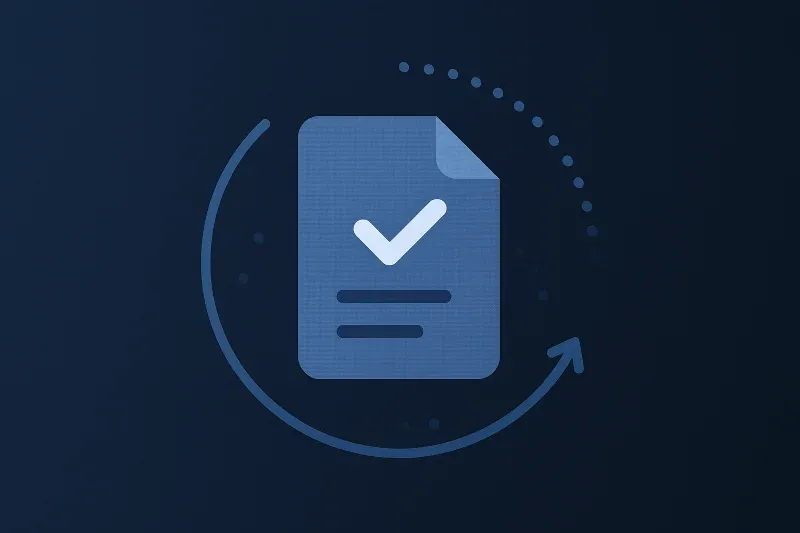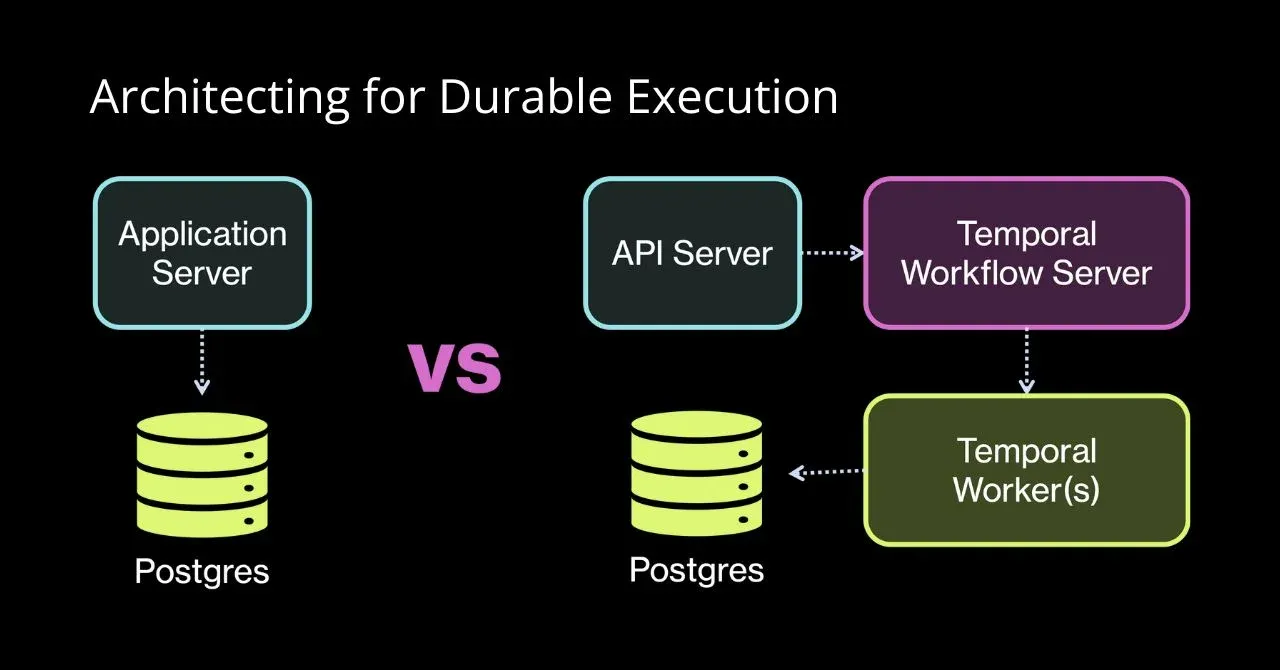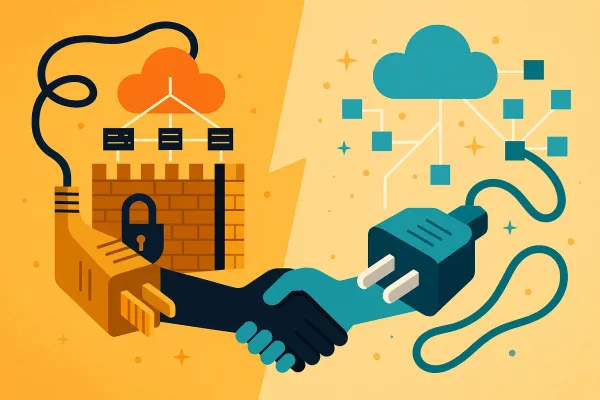DBOS vs. Temporal - Choosing Your Durable Executor

Backend development increasingly demands applications that are not only scalable but also inherently reliable. Durable execution platforms like DBOS and Temporal have emerged as viable options for production software, offering solutions for building and operating complex, distributed systems. This post provides a comparison to help software engineers, particularly those targeting on-premise deployments, understand the trade-offs between these two powerful tools.

In this post, we assume a foundational understanding of what durable executors are. If you are new to the concept the following can be good resources to familiarise yourself with the concept and the opportunities it presents.
- Building Reliable Applications with Durable Execution by Temporal
- Making Apps Durable with 10x Less Code by DBOS
- The Principles of Durable Execution Explained by inngest
Architectural Overview
A fundamental difference lies in their architecture. DBOS is designed as a lightweight, open-source library that operates entirely within your application process. This embedded model tightly integrates durable execution capabilities within the application code itself. In contrast, Temporal employs a client-server architecture where a central Temporal server coordinates tasks across distributed worker processes. This distinction has significant implications for deployment complexity, performance, and code integration.
Feature-by-Feature Comparison
Both DBOS and Temporal offer a comprehensive set of features for building reliable and scalable backend applications. Here's a breakdown of key aspects:
Workflow Definition and Execution:
- Both adopt a code-first approach, allowing developers to define workflows and their steps directly within the application code using decorators (DBOS in Python and TypeScript ) or SDKs (Temporal in Go, Java, Python, TypeScript, and .NET ).
Durability:
- DBOS achieves durability by persisting workflow execution state in a Postgres database. It automatically recovers and resumes workflows from the last completed step after crashes.
- Temporal uses a central server to store workflow and activity states. It leverages event sourcing, recording every state change as an immutable event, enabling automatic retries and workflow replay.
Failure Handling and Retries:
- DBOS provides built-in mechanisms for retrying individual steps within a workflow and ensures exactly-once processing for events and scheduled jobs. It also emphasizes transactional idempotency.
- Temporal offers configurable retry policies and timeouts for activities. While Temporal provides the infrastructure for reliability, ensuring activity idempotency often falls to the developer.
Task Scheduling:
- DBOS simplifies scheduled tasks using decorators like
@DBOS.scheduled(). - Temporal offers "Temporal Schedules" as a durable and controllable alternative to traditional cron jobs.
Database and Language Support:
- DBOS primarily supports Python and TypeScript and relies heavily on Postgres as the underlying database.
- Temporal offers SDKs for a broader range of languages and supports multiple databases, including Apache Cassandra, MySQL, PostgreSQL, and SQLite.
Observability:
- DBOS automatically emits OpenTelemetry traces and provides a cloud console and CLI tools for monitoring. It also features a "time-traveler" debugger in DBOS Cloud.
- Temporal provides detailed execution history, a Web UI, and exposes metrics for integration with tools like Prometheus.
Self-Hosting Considerations
- DBOS: Self-hosting DBOS is relatively straightforward, primarily requiring access to a Postgres server. Its embedded architecture simplifies deployment. Managing workflow recovery in distributed environments involves assigning unique executor IDs. Upgrading requires careful management of application code versions.
- Temporal: Self-hosting Temporal is more involved due to its multi-component architecture, including frontend, matching, history, and worker services. It also requires a supported persistent storage layer. Deployment options include Docker, Go binaries, and Helm charts for Kubernetes. Scaling involves considering the number of shards. Ongoing maintenance includes monitoring server processes and the database.
Tradeoff: DBOS offers a significantly simpler self-hosting experience due to its lightweight architecture and single dependency on Postgres. Temporal, while more complex to self-host, provides greater flexibility in database choices and deployment methods.
Comparison Use Cases for On-Premise Deployment
Here are some examples to illustrate the tradeoffs in choosing between DBOS and Temporal for on-premise deployments:
Use Case 1: Simple Background Jobs and Cron-like Tasks
- DBOS: For applications primarily needing to run simple, recurring background tasks or cron-like jobs within a Python or TypeScript environment, DBOS's straightforward decorator-based scheduling and easy self-hosting with Postgres can be advantageous. The lower operational overhead might be preferred for smaller teams or less critical applications.
- Temporal: While Temporal can also handle scheduled tasks reliably, its more complex setup for on-premise deployment might be overkill for very basic scheduling needs. However, if the scheduled tasks are part of a larger, more complex workflow that requires robust failure handling and observability, Temporal's capabilities would be beneficial.
Use Case 2: Complex, Long-Running Workflows with Multiple Steps and External Integrations
- Temporal: For intricate workflows involving numerous steps, interactions with external systems, and the need for high reliability and fault tolerance, Temporal's mature platform with its extensive features like workflow replay, configurable retries, and broad language support makes it a strong choice. Its ability to handle long-running operations and manage state reliably is crucial in such scenarios.
- DBOS: While DBOS supports long-running operations and provides retries, its relative immaturity and tighter coupling with Python/TypeScript and Postgres might present limitations for highly complex workflows involving diverse technology stacks or requiring advanced features available in Temporal.
Use Case 3: Data Pipelines and Batch Processing
- Temporal: Temporal's ability to ensure the reliable execution of multi-step workflows makes it well-suited for building robust data pipelines and batch processing systems, even on-premise. Its flexibility in database support can be beneficial if the existing data infrastructure includes Cassandra or MySQL.
- DBOS: DBOS highlights its capability to build resilient data pipelines with durable queues and built-in observability. For organizations primarily using Postgres and Python/TypeScript, and seeking a simpler setup, DBOS could be a viable option for data processing tasks.
Use Case 4: AI/ML Workflows
- DBOS: DBOS specifically targets AI agents with features like automatic retries and long-running capabilities, along with integrations for LangChain and LlamaIndex. For teams focused on deploying AI/ML applications on-premise using Python and Postgres, DBOS offers a streamlined experience.
- Temporal: Temporal is also used in AI applications, supporting long-running tasks and providing resilience. Its broader language support might be advantageous if the AI/ML workflows involve languages beyond Python.
Conclusion
Both DBOS and Temporal are powerful tools for building reliable backend applications. The choice between them for on-premise deployments hinges on factors like the complexity of your workflows, the size and expertise of your team, your existing technology stack, and your tolerance for operational overhead.
- Choose DBOS if you prioritize rapid iteration, ease of use, and simpler self-hosting within Python and TypeScript environments, particularly if you heavily rely on Postgres.
- Choose Temporal if you require broad language and database support, and a more feature-rich platform for handling complex workflows, even if it involves a more complex on-premise setup.
Ultimately, evaluating your specific use cases and the tradeoffs discussed will guide you in selecting the durable executor that best fits your on-premise software engineering needs.
Further Reading
- DBOS Official Website: DBOS | Build Reliable Backends 10x Faster, Scale to Millions with 1 Click - This is the official website for DBOS, providing comprehensive information about the platform.
- Temporal Official Website: Temporal: Durable Execution Solutions - The official website for Temporal, offering extensive resources and documentation.
- Self-Hosting DBOS Apps: Self-Hosting DBOS Apps - This page from the DBOS documentation provides specific details on how to self-host DBOS applications.
- Deploying a Temporal Service: Deploying a Temporal Service - This section of the Temporal documentation guides users through the process of deploying a Temporal service.
- Temporal Platform's production readiness checklist: Temporal Platform's production readiness checklist - This checklist outlines important considerations for running Temporal in a production environment.
- Deploying DBOS To Production: Deploying To Production - This post highlights essential information around working with DBOS in production.



